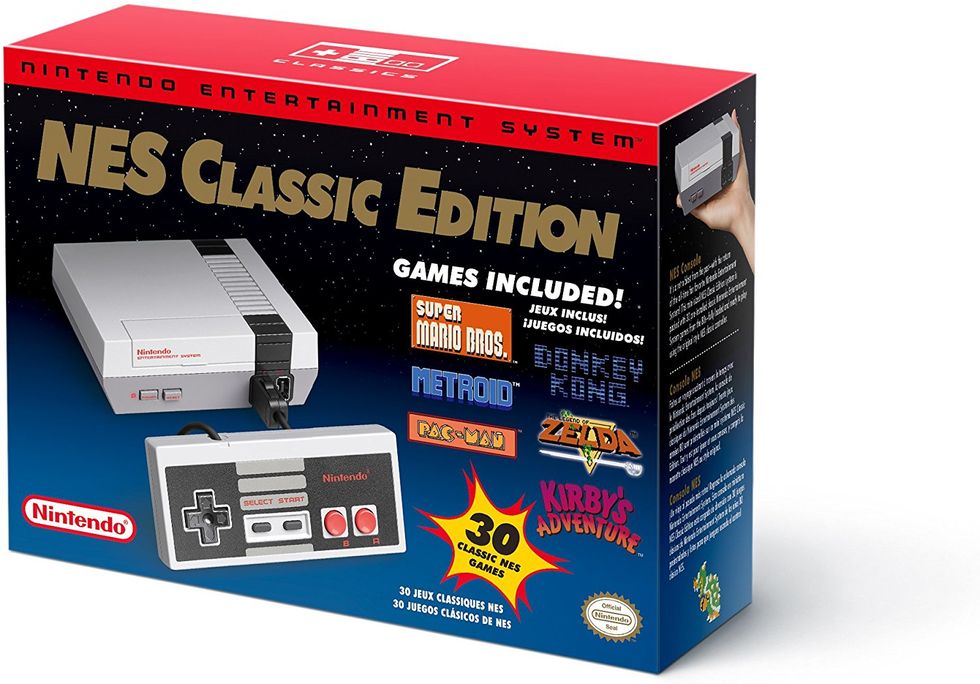Nintendo has fallen on some hard times over the last few years, especially due to low sales figures on the Wii U, but around 2016, things started to turn around. They released a plug-and-play type console, the NES Classic Edition, preloaded with thirty NES hits. It was a major success, local stores did raffles (as Nintendo only sent a small number to each store, but more on that later.) Essentially, the console was an emulator – which has become a popular way of playing retro hits without exactly needing the original console. It seems that retro gaming is coming back, be it downloadable classic games on Steam or other online marketplaces, or even arcades being opened with the famous cabinets and pinball machines. But in today's world of gaming, where you can free roam fantasy worlds and play online with people all around the world, why would people want to go back to the basics?
The NES Classic Edition was far from
the first remake of a famous video game console. Atari and Sega both
have made remakes of the 2600 and the Genesis, though those are
pretty affordable and are pretty easy to find, compared to the NES
Classic. And as I stated, emulation is a popular system online –
you can download a program for Super Nintendo, N64, Dreamcast,
PlayStation, you name it – if it's a console, there's either an
emulator for it or one in development. Because of the easy access to
such programs, and the availability of ROMs (games unofficially
ported for use in emulators), many have worked to make “ROM hacks”
of iconic games, such as the infamous Kaizo Mario,
thus bringing new life into the games many played as children. The
Retron console line is an affordable remake of the NES, Super
Nintendo, and Genesis all in one single machine, providing high-end
emulation for all three consoles and a cheap way of replaying your
classic game library you found in the attic. You can go right online
and, for free, spend a few hours reliving rainy afternoons playing
Nintendo. The actual companies usually turn a blind eye to emulation,
often producing ones of their own to compete with the market – but
at the same time, they are aware if someone buys an original
Dreamcast at their local video game store, the store gets the money,
so it doesn't matter if they're getting it for free or not.
Arcades
have made a comeback as well, not unlike vinyl records and cassette
tapes. Movie theaters and department stores often keep a few games
set up, mostly your racing and shoot-em-ups so when you're waiting
for the movie to start, they can get a few more dollars in quarters
out of you, but if you look hard enough, you can find classic style
arcades. For example, I used to go to a roller skate rink before it
went downhill fast – and they had several arcade cabinets,
including a obvious Doom clone
and the original Marvel vs. Capcom. I'd
be lying if I said I played more of that than I did on the rink. And
now, in 2018, another arcade opened up in Maine, this one in Augusta
– and they have it all, from Mrs. Pac-Man to
a very recent Batman game with HD graphics - which means companies still produce arcade cabinet games. Yeah, kids show up, but you know the
parents also go and have a good time because they remember these from
their youth, thus allowing the generations to come together under a
single roof to play some video games and set a quarter on the
machine. And like vinyl, it seems like a small market – but usually
arcades are near other places like stores, so now you have a place to
either drop off your kid or you can relax after a shopping trip. Add
in that shows like Stranger Things
are popular with a younger crowd, and the show involves things from
the 1980s like arcades, Dungeons and Dragons,
and classic rock – now kids want to go to a similar place and play
the same games.
However,
while those have contributed to the retro revival, it really boils
down to nostalgia for the 1980s and 90s kicking in. From movie
adaptations of Transformers and
tributes like the previously mentioned Stranger Things,
the children of the 80s have grown up, but never lost the nostalgia
for the past, which is true for all generations. These kids now have
kids of their own, and while those children may be able to play great
games like Halo and
BioShock, the parents
remember a time where Nintendo ruled the roost – and in the case of
Nintendo, game series like Mario, The Legend of Zelda,
Metroid, and Pokemon
have continued to produce new
games and new content regularly, thus allowing today's youth to have
“their Zelda” and
another group of Pokemon that they can name, but 90s kids can't keep
up with (the Kanto region, oh yeah I can name them off). Nostalgia
comes to every generation, but with the millennials, they have the
ability to go online and get aspects of their childhood, still in
relative high definition.
Everybody
has that thing that reminds them of the “good old days,” whether
it's music or TV shows or even a teapot, we all get nostalgic for
something. And with the current group of young adults, they grew up
with the rise of video games, hence why now we're seeing an 80s
revival. From It being
moved to take place in 1989, to re-releases of classic video game
consoles, to 80s pop getting airplay on radio again, peak nostalgia
has come into play. You can drive half an hour and play a few games
at the arcade, you can play Super
Mario Bros and
Sonic the
Hedgehog
on your home computer without any issue (there's even controllers you
can buy for them). In time, we'll see a revival of things we grew up
with, like the Gamecube and Windows 95 games. For now, we're able to
practically go back in time and play out the games that made the
industry what it is today. Retro gaming is in its peak, and it's not
going anywhere anytime soon.


















